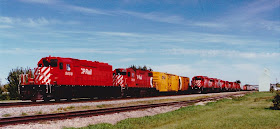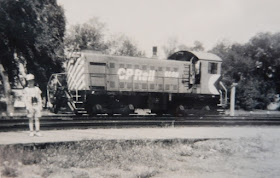The original alignment of the Grand Trunk Railway's double-track mainline through Kingston (eventually CN's Kingston Sub) included a sharp curve at the site of the 'Outer Station' on Montreal Street. The 'Inner Station' was located on Ontario Street at the end of the Hanley spur. Aerial photo (below) from Queen's University Archives shows: 1-CP line to industries north of Outer Station - this line originally crossed the GT(CN) west of the station yard via a diamond, before being relocated to an overpass near Division Street, 2-Gould Battery and Frontenac Floor & Wall Tile Co., 3-engine house, 4-Outer Station, 5-stock pens, 6-Montreal Street underpass below Kingston Sub, 7-Hanley Spur.
Another George Lilley view, this one taken from the north-east in 1948:
Another George Lilley view, this one taken from the north-east in 1948:
A 1939 Canadian Geographic Journal photo showing the Royal couple detraining at Kingston in 1939, posted by my brother and showing the Royal Train in the background:
A 1951 Vintage Kingston view of two CNR passenger trains meeting at the west end of the station trackage, looking toward Elliott Avenue. Interestingly, Mike Hamer posted a series of Kingston Outer Station photos in 2013 including this one. These photos had been left to Mike by his father in a booklet.
The original limestone one-and-a-half storey section was built in 1855, with its ashlar surface and cutstone quoins, albeit without its mansard roof which was added sometime between 1875 and 1885. Kingston’s station, like the others on this part of the line, was completed during the span of two years: Shannonville and Prescott in 1855; Kingston, Ernestown, Grafton, Napanee, Trenton, Belleville, Port Hope and Brighton in 1856.Deemed the Outer Station, at present-day 810 Montreal Street, the one-and-a-half-storey stone GTR 7-bay Type A station had a gambrel roof with five gabled dormers on a curved attic extension of eaves to shelter passengers on the platform. Curved brackets led from the first storey to the buried roof dormers. Round-arched windows were reminiscent of the solidity displayed by Roman - Neo-Classical style of architecture used for public works, installing an air of permanence and confidence, even of Empire! Its Italianate proportions are attributed to Sir Francis Thompson, GTR’s Montreal architect.
A second, brick building was added in 1895-1898, sitting 100 feet east of the first, echoing its design features with seven arches and similar supporting brackets. The brick has been heavily-painted, with a low, single-storey wooden structure added between the two.
The earlier limestone building hosted offices and waiting room until at least 1892. The second building housed a lunch room. In 1939, the earlier building was converted to the baggage and express room and station functions moved over to the second building. Renovations in 1970 included extending ticket sales counters when sales staff relocated from the Princess Street ticket office. This Canadian Science & Technology Museum photo CN001091 shows both main tracks, with cars in the yard at left in 1974:
The obviously dangerous curve, with a 30 mph speed restriction, caused at least one train to leave the rails (CNR 5702 in 1947), before CN successfully realigned its main line through a deep limestone cut north of Elliott Avenue between Division Street and Montreal Street, in October 1974. Some accounts say the realignment opened July 24, 1975. A westbound freight behind 3625-3108, including penultimate Penn Central covered hopper PC 888173 and caboose 79471 rode the welded rail and concrete ties on February 21, 1976, photographed from Montreal Street:
Concurrent with the realignment, CN moved its station functions to a new location off Counter Street near Princess Street. A December 13, 1972 Kingston Whig-Standard article discusses the soon-to-be-built station. Its expected completion date was June, 1974.
Concurrent with the realignment, CN moved its station functions to a new location off Counter Street near Princess Street. A December 13, 1972 Kingston Whig-Standard article discusses the soon-to-be-built station. Its expected completion date was June, 1974.
The new station was officially opened on October 26, 1974. I've photographed some interesting Kingston platform scenes at this 'new' station over the years. Opening day, CSTM photo CN005133:
On June 27, 1973 RMC cadets and Kingston's Canadian Forces Vimy Band await the arrival of Her Majesty Queen Elizabeth II, arriving to celebrate Kingston's Tercentenary (L.C. Gagnon photos, below). In 1984, the Royal Train arrived at the new station.
This interesting photo, from the archives of the City of Montreal, shows a train of VIP's arriving from Montreal at the Outer Station. Met by City of Kingston Police patrol cars, the visitors will take part in preliminary planning for the 1976 Summer Olympics sailing events that were based at the Portsmouth Olympic Harbour:
Another rear view of the station taken in 1972, with a CN AMC Hornet in the foreground, and CN passenger train stopped at the station, from Vintage Kingston Facebook:
In March, 1974 this online auction site photo shows an eastbound CN passenger train making its station stop. Note the DuPont maroon-coloured covered hoppers at right:
CN 810454 is a former stock car in MOW gang service. Coupled to a rebuilt boxcar purpose-built to carry flammables, the slats provide ventilation in this previous iteration. This online auction site photo is captioned 1983. The cars are a few tracks over from the occupied boarding cars. The Outer Station is visible in the background:

Though I vaguely recall some visits to the Outer Station to meet CN passenger trains, I mainly remember it being a stub-ended yard, with the westward yard lead joining the main on the south track of the Kingston Sub immediately east of Division Street. An eastward view of the yard in 1978 reveals a local switcher with a CP boxcar (CSTM Collection MAT006979)
Phil Mason kindly shared a photo of the Outer Station taken in 1972:

And a corresponding westward view shows the CN express building, mainenance-of-way cars, track machines, covered hoppers likely destined Northern telecom, and 40-foot CN boxcars. In both views, the former south main track, nearest the station, has been removed. (CSTM Collection MAT006980)
The 1910 Montreal Street underpass was removed in March, 1976 severing the eastward connection to the Kingston Sub. Even after stub-ending, the station area provided CN with a small yard from which to serve local industries. CN business car Bonaventure and transfer caboose 76554 repose at the Outer Station on April 17, 1982 in this Kingston Rail photo:
The yard also held the late evening passenger equipment overnight for the morning run to Toronto, as seen in these photos taken by Doug Rickaby at 0545 on a summer morning in July 1985:
The yard also provided a maintenance base for vehicles and rail equipment, including CN crane 50367, its idler cars, and covered hoppers for Northern Telecom, in January 1980.
The Pandrol-Jackson RMS13 rail-grinding train has arrived, on July 8, 1994. Very few tracks remain.
This Tim Reid photo is undated, but I'm willing to bet it was taken at the same time as mine. I'm also willing to bet that Tim marched all the way up to the head-end to get it:
A restaurant operated in the Outer Station between 1989 and 1992, as CN sought to retain the 1.3-acre site, and its three buildings occupied. The remaining yard track and connection to the mainline were last used for a rail safety display in June, 1995. CN Mobile hazmat response trucks, boom truck, snowplow and caboose are on display.
Over 700 area schoolchildren toured the displays over three days.
Now the station is a political football, uncared for by CN, its roof removed and walls stabilized by order of the city. A far cry from its heyday, including an 1872 campaign visit by Sir John A Macdonald, including an elegant oyster supper! In the second Outer Station post, we'll see what happens when you decide to kick a caboose. Hard.
Running extra:
I just finished listening to Regis Philbin's How I Got This Way. An engrossing tale of Regis' showbiz life, including his self-doubt, successes and stories of stars like Bing Crosby, his famous female cohosts, and the inimitable Don Rickles. Don: "Go ahead Frank [Sinatra], make yourself at home. Hit somebody!" The book made me talk like Regis for awhile. IS THIS GUY NUTS OR WHAT? I MEAN, REALLY!
And the Oscar goes to...Will Ferrell and Zach Whatsisnamakis for this hilarious bit of cymbalism from the 2012 Awards.
Modelling Winnipeg? Here are some cool retro scenes from the 1950's to the 1970's. Watch for the towering Ogilvie Flour Mill at the 3:07 mark. Got BC Rail? Check out these amazing track geometry car scenes. Dave: thanks for the latter link!


















.jpg)






































